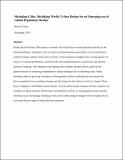Shrinking Cities, Shrinking World: Urban Design for an Emerging era of Global Population Decline
Author(s)
Ryan, Brent D.
DownloadShrinking Cities_Shrinking World_Preproof_2019.pdf (1.180Mb)
Open Access Policy
Open Access Policy
Creative Commons Attribution-Noncommercial-Share Alike
Terms of use
Metadata
Show full item recordAbstract
During the mid-to-late 20th century, economic and social forces caused population decline in the
deindustrializing, “shrinking” cities of many developed nations, particularly in the United States,
northern Europe, and the former Soviet Union. Urban designers struggled with varying degrees of
success to confront problematic conditions like housing abandonment, vacant land, and disused
factories. Germany, with abundant state funding and a design-oriented culture, achieved the
greatest success in instituting comprehensive design strategies for its shrinking cities. Today,
shrinking cities are growing in number as demographic decline resulting from income growth
drives population loss in northern Europe and the former Soviet Union as well as in Japan, China,
Korea, Singapore, and Mediterranean Europe. Nascent urban design strategies include compact city
strategies in Japan and state-led housing consolidation in China. As demographic decline spreads
elsewhere in an increasingly shrinking world, novel urban design strategies will be required for an
ever more diverse range of urban built environments.
Date issued
2019-06-19Department
Massachusetts Institute of Technology. Department of Urban Studies and PlanningPublisher
Routledge
Citation
Banerjee, T., & Loukaitou-Sideris, A. (Eds.). (2019). The New Companion to Urban Design (1st ed.). Routledge.
Version: Author's final manuscript
ISBN
9780203731932
Collections
The following license files are associated with this item: